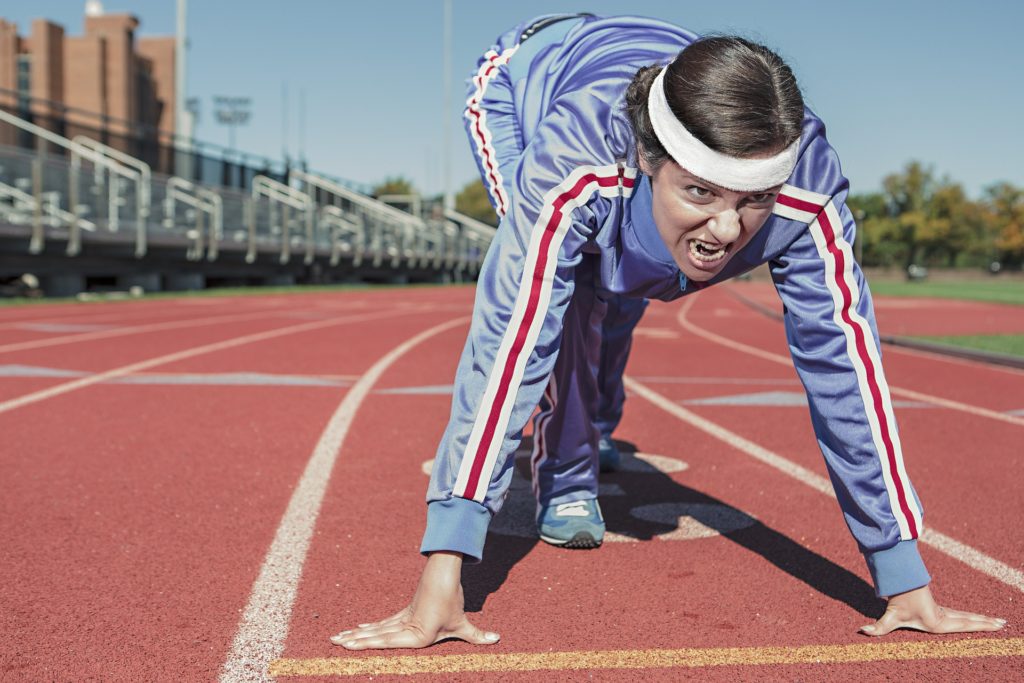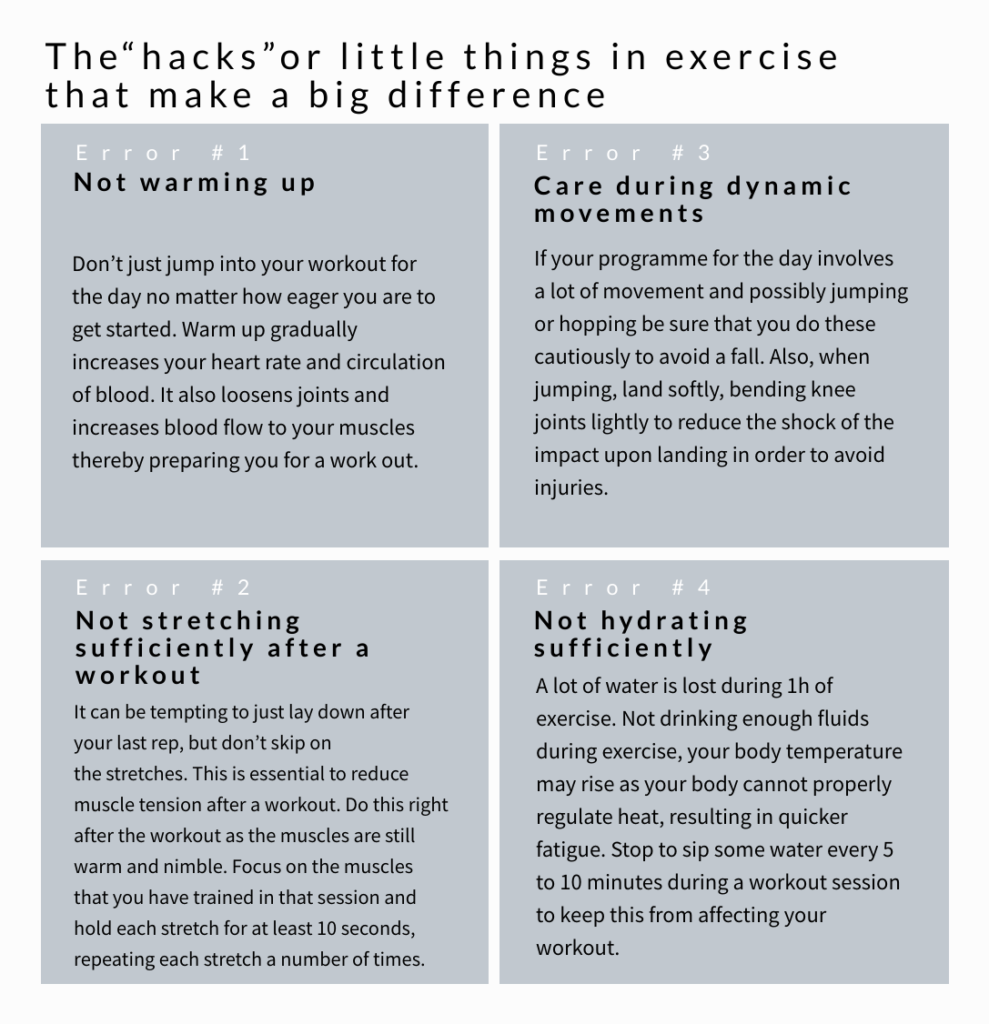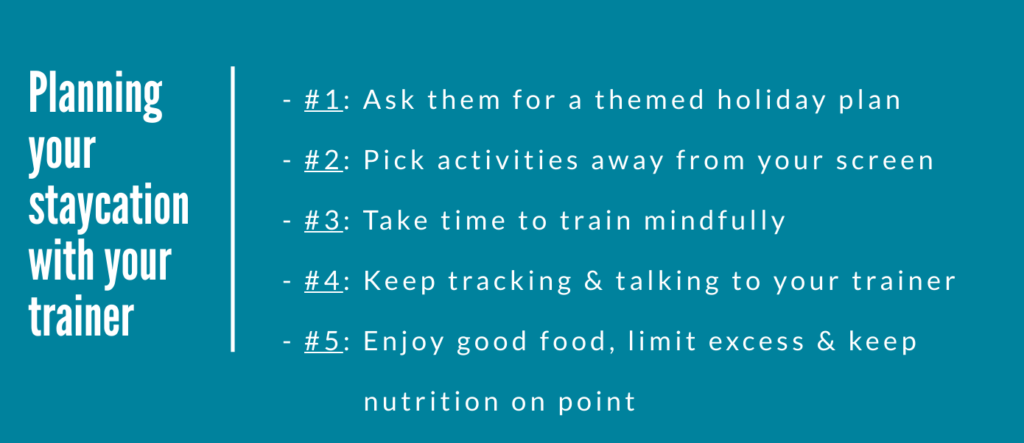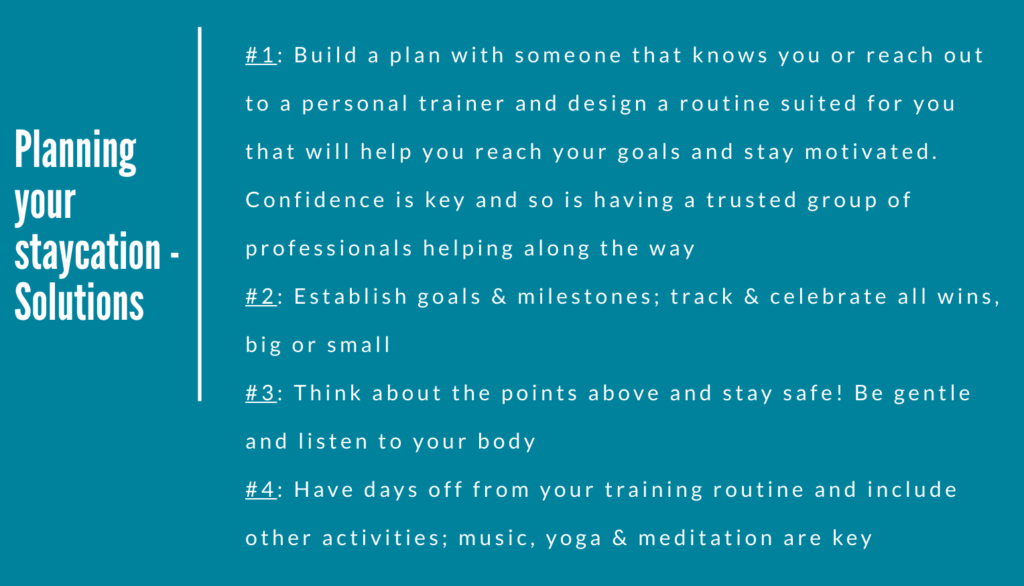This month, we bring you a two-part series looking at helping you make the most out of your Staycation. With spring in full swing, some of us are finding our ways back to the gym and to outdoor sporting and/or social activities, with even a glimpse of holidays abroad still on the horizon for some lucky ones. Whether you are still training at home or adapting to the new reality of practicing your favorite activities under the new rules of the deconfinement, in this 2nd part of our May newsletter, we dive into some practical ways of staying safe and injury-free and how to put this all into practice.

As we’ve been exploring in our last publications, motivation, commitment and setting achievable goals are all part of the course. As Corona sprung itself on the world, putting many of our traditional patterns of life into disarray, fitness has not been immune. Though it is the perfect storm for YouTube fitness coaches to gain substantial visibility, we like to share with you in this 2 part newsletter the importance of how wellness and tailoring your workouts is key to 360° success & happiness and the benefits of working with a personal trainer.
The do’s & dont’s of training on your staycation
There’s two faces to every coin. In the current situation, this means lack of time and too much time. Staying motivated and consistent comes with another set of challenges. With the abundance of online training options and videos, the combination of overzealousness and trying random new ideas (which seem good at first), might lead to injury, not achieving the desired results and loss of motivation.
Spicing up your life and your training routine is good; however jumping from one fad to the other is a known recipe for disaster. Consider the 80/20 rule, and apply it to finding the right balance between exploring new challenges and maintaining the status quo.

Avoiding Injury (when training at home)
Though it does not require much to train at home (improvise, adapt and overcome) it is very easy to hurt yourself when training on your own and in an environment that’s not tailored towards physical training. As much as we are encouraging you all to get active while at home and giving you ideas on how to do this, we want you to stay safe and avoid injury. Let’s touch briefly on some causes and areas for you to look out for.
#1 – Poor Form
Poor form is a double-edged sword. For one, it results in inefficient movement. This then means that in doing an exercise with poor form, you engage additional muscles that shouldn’t be a part of that workout and thus deny the target muscle the full attention needed. This can substantially slow down your progress.
However, more directly related to the topic of safety is the second problem with poor form – it can result in injury. Not doing an exercise in the right way can result in straining a secondary/ related body part. With enough weight involved, you could easily injure that other part. A prime example of an exercise that many people do incorrectly is the deadlift. This can result in damage to your back when not done correctly. When attempting a new exercise at home (or even those you’ve done over time), it helps to check on your form comparing what is advised versus what you’re doing by checking yourself in a video or on a mirror.
Proper form will help build a strong foundation as you progress through this journey. So get it right from the start. It will save you a lot of trouble down the line.
#2 – Being “too ambitious”
This happens when someone is extremely excited and eager to get into a new regime.
In a bid to tap into every bit of physical and mental energy, they do 20 reps instead of the 10 reps per set they were advised to. And 50 push ups instead of 20 and so on. Overexerting the body carries risk especially when going substantially beyond what you’re used to. This usually happens with beginners or people looking for a quick result. Body changes are anything but quick.
Just like Rome wasn’t built in a day, you must take time and be cautious not to bite off more than you can chew. Be pragmatic and methodical in your approach to avoid hurting muscles and joints through overexerting yourself.

#3 – Poor Mobility
In the same vein, people sometimes want to try things that their body isn’t ready for or used to. This could be a new movement or a tougher version of an existing exercise.
Mobility is the ability to move a limb freely and easily through it’s full range of motion. Don’t confuse this with flexibility. Physical exercise contributes substantially to one’s mobility and good mobility helps you get more out of your workouts; this develops over time. Your range of motion when you begin an exercise (such as a squat) is quite different a couple of months in. And this varies with age, lifestyle and a number of other factors. However, it is something that can be developed and should not be forced otherwise it could result in joint or muscle injury.
#4 – Inadequate Gear and Environment
If you’re training at home, it is highly likely (unless you’re one of the few with a home gym), that for at least some of your exercises you will have had to improvise in one way or another. While this is encouraged, we cannot stress enough that you ensure that whatever you use is adequate for the purposes you are using it for. If it is a weight, ensure that it is balanced and when lifted, it won’t lean to one side for instance. Ensure that the surface you’re training isn’t slippery and also isn’t too hard. If possible, place a mat underneath you when you train regardless of whether or not you will be laying down. You want a good surface to stand and land on in the event that you are doing exercises that involve jumping or other dynamic movement. And speaking of jumping, please make sure you have the right shoes to train in. Your knees will thank you later.
#5 – Poor Practice
There are many “hacks” or little things in exercise that make a big difference. The “how” of many things can compound either for or against you depending on your approach. Similar to poor form discussed earlier, there are a number of practices that people leave out or ignore or don’t do enough of. Pay close attention to these as they can save you a lot of trouble.

This list isn’t exhaustive but hopefully gives you a good sense of some areas to put in extra caution as you work out at home. At the end of the day, it helps to work with somebody who can guide you through the do’s and don’ts.
What Kind of Pain to Expect
“No pain, no gain” is a phrase we hear a lot in the gym in relation to working out. There’s some truth to this. The way muscles grow is through micro-tears on individual muscle fibres through exertion during exercise. The muscles then physically grow though repairing these tears by adding new muscle tissue. This process often results in what’s called Delayed Onset Muscle Soreness (DOMS). This kind of pain can be quite uncomfortable depending on how much “damage” has been done to the muscles you’re working out. It can result in you wanting to restrict your movements around the muscle group that’s sore based on what you recently worked out. It is also a delayed response in that you will not feel this immediately after your session but rather a day or two later.
Don’t let this get you down. If anything, stretching or warming up the muscle group in the days after the workout will help reduce the soreness. Using a foam roller too will ease this and in cases where you find it unbearable, you may need to apply a pain relief cream or balm to the affected muscles. Proper nutrition with a good amount of protein will also help ease this as muscles are essentially made of protein. Some people opt for supplements that contain BCAA’s as these tend to speed up the healing and allow you to then comfortably work out the muscle group again especially since the soreness can last for a few days.
This kind of pain is not a bad thing. But listen to your body as you wouldn’t want to stress muscles that are in the process of healing as this could result in more tears and more pain. We shall be delving deeper into DOMS in a future newsletter so keep coming back to check if this is something of interest to you.

One other thing to expect is knots or “trigger point” pain. Trigger points are irritable spots in skeletal muscles. A lot of these typically occur in the back. Working out muscles around a trigger point can increase the pain/ discomfort making you less willing to exercise. These can be released through applying sustained pressure on the area to release the tension/ deactivate the trigger point and relax the muscle.
All in all, if any form of pain persists, consult a doctor in order to avoid any long term damage to your body. We need you in good shape.
Making the Most of Your Fitness Routine While on Your Staycation
So how do you put this into practice? The key themes here are listening to your mind and body, staying consistent and patience. No matter how much you want to achieve your goals, don’t over do it; now matter how fun that home routine or hike looks, listen to your body and choose what is right for you.
Remember the body needs time to adjust, and sometimes this means slowing down through the ancient arts of meditation and relaxation. The human body is complex and as described above, if you put it through too many new external shocks, the resulting pain or injury might be a sign that it’s time for a timeout and to include other types of other forms of wellness into your routine.

If you have too much energy and miss group activities and feel like starting a challenge with your family and friends. Build your perfect staycation, design the routine that goes with it, ask your trainer to help you adapt it to give it that holiday feel – whatever it takes for you to break away and escape from the day to day routine and provide you with similar feelings a more traditional holiday will; who knows, you might be surprised! Whatever you do, make it a staycation to remember!

There is no shortage of options in terms of keeping busy while keeping fit in this time. Habits we build now will last for a long time to come, so lets build good ones that benefit our health and wellness. If you’re not sure where to start, reach out to us and we’ll virtually hold your hand and share some ideas on how to get started. For those who have already begun, keep at it.
Just like the house is built, brick by brick, so too your body is built, rep by rep! Stay safe
Stay tuned for our special Edition Room 101 – Doctor’s Orders where we look at common questions and clear up some misconceptions that arise when people engage in physical training from a medical perspective, as well as at ways in which this translates to home-based training. In this series of Q&A, we do a deep dive with Dr. Akala to clear the air and get advice on a wide variety of issues.
If you like the look and sound of this and want a free consultation with our trainer, just fill in the contact form, and get in touch!

Very informative article